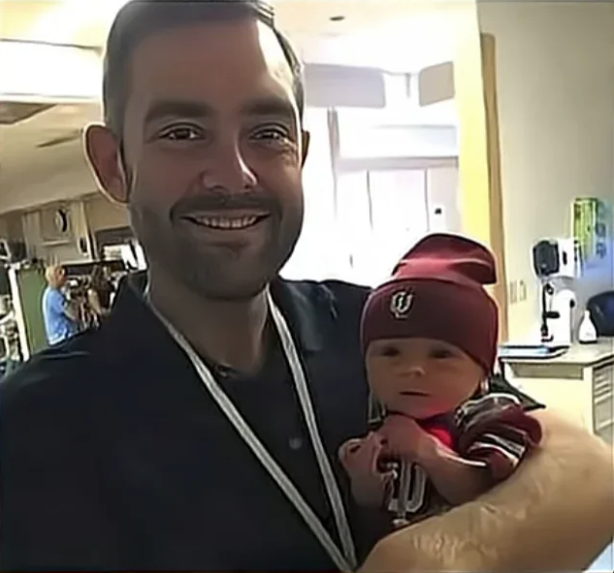
For nine months, Brooklyn carried their baby boy with severe hydrocephalus. Top specialists at Cincinnati Children’s Hospital gave devastating news: more than 90% chance he’d die or survive with severe brain damage.
They discussed removing life support before he was even born. Making the impossible decision to let go before ever saying hello. Preparing for a funeral instead of a nursery.
But Charlie Edward came into the world crying.
Not the weak, struggling cry of a baby fighting for life. A strong, healthy cry. The kind that makes nurses smile and parents weep with relief. A cry that said: I’m here, I’m alive, I’m fighting.
After weeks in NICU, he’s home and thriving. Doctors can’t explain how his brain cleared the blockage that should have killed him or left him severely disabled. They call it a miracle—the only word that fits when medicine has no explanation.
The photo shows Charlie Edward’s father holding him in what looks like a hospital room. The dad is wearing a dark shirt with a lanyard, smiling broadly—the exhausted, grateful smile of a parent whose child survived impossible odds. Charlie Edward, dressed in a maroon outfit and matching hat, is awake and alert in his father’s arms, looking healthy and content.
They look like any new parent and baby, except for the story behind them. Except for the nine months of terror Brooklyn endured. Except for the 90% death sentence. Except for the discussions about removing life support.
“For nine months, Brooklyn carried their baby boy with severe hydrocephalus.”
Imagine that pregnancy. Every doctor’s appointment bringing more bad news. Specialists explaining the severity, the statistics, the grim reality. Other parents excitedly preparing nurseries while you’re discussing end-of-life decisions for a baby who hasn’t even been born yet.
The strength it takes to carry that pregnancy to term when doctors are telling you there’s a 90% chance of death or devastating disability. Most people would understand if Brooklyn had chosen differently. But she carried him. Chose hope over statistics. Chose to give her son a chance even when medical experts said his chances were nearly nonexistent.
“They discussed removing life support.” Before Charlie Edward even took his first breath, his parents were having conversations about letting him go. About whether it was kinder to prevent suffering than to fight for a life that might not be viable.
Those are the conversations no parent should have to have. The impossible decisions that make you question everything you believe about hope and faith and when to keep fighting versus when to let go.
But Charlie Edward came into the world crying. Made that decision for them. Announced his arrival with a strong, healthy cry that said: I’m here, I’m fighting, I’m not giving up.
And he’s been fighting ever since. Weeks in NICU—the exhausting routine of hoping and waiting, of tiny victories and scary setbacks, of learning to interpret medical equipment and trust nurses and somehow keep believing when you’re terrified.
And now he’s home. Thriving. Defying every statistic, every prediction, every medical expectation. His brain somehow cleared the blockage that should have been fatal or debilitating. The hydrocephalus that defined his prenatal diagnosis isn’t defining his life.
“Doctors can’t explain how his brain cleared the blockage.”
That’s the part that makes this truly extraordinary. If doctors could point to a specific intervention or treatment and say “this is what saved him,” it would still be wonderful but it would be medicine. Explainable. Repeatable.
But they can’t explain it. His brain just… cleared. The blockage resolved itself in a way that medical science doesn’t fully understand. The 90% death sentence was overturned by mechanisms doctors can’t identify.
So they call it a miracle. Because what else do you call it when a baby defies a 90% chance of death, when hydrocephalus resolves itself, when medical impossibility becomes lived reality?
Charlie Edward is home and thriving. That’s the sentence Brooklyn probably didn’t dare believe she’d ever say. After nine months of carrying a baby with a death sentence. After weeks in NICU. After so much fear and prayer and desperate hope.
He’s home. He’s thriving. And his father holds him with the grateful smile of someone who knows how close they came to losing everything, and how blessed they are to have this moment.
The photo could be any dad with any baby. That’s the miracle—that after everything, Charlie Edward looks like a healthy, normal baby. That you can’t see the diagnosis in his face. That he’s defying expectations so completely that he just looks like any other infant in his father’s arms.
Doctors call it a miracle. His parents probably call him their miracle. And Charlie Edward? He’s too busy thriving to worry about what anyone calls him.
He came into the world crying, defying a 90% death sentence with his first breath. And he’s been defying expectations ever since.